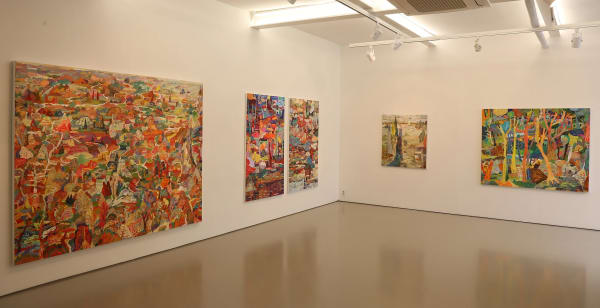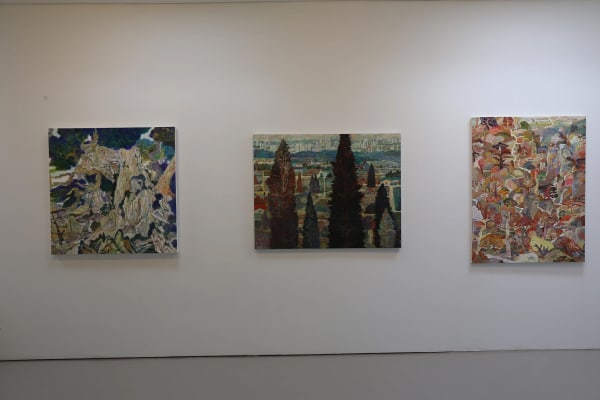이상권 : 불완전한 풍경
이상권 작가에게 이번 전시는 풍경이 깊은 고유의 의미와 심미적 내용을 담을 수 있느냐 하는 화두를 전면에 걸고 준비하였다. 지난 4년간 경기도 파주로 이주한 후 작가는 지난시기 그의 회화의 중심을 이루었던 도시와 일상, 인물들을 화면에서 배제하고 파주의 자연과 풍광을 담담하지만 섬세한 관찰과 표현으로 화폭에 담았다. 도시와 인물이 사라진 나무와 돌과 숲과 그 사이사이 길들이 화면을 가득 채우고 있다. 대상의 크기와 상관없이 이미지 하나하나가 매우 끈기 있게 표현되어 있으며 화면은 중심과 주변의 구분 없이 균일하게 우리의 시선을 끌어들인다. 그러나 그의 작가로서의 태도와 작업방식은 과거와 마찬가지로 관찰과 재현, 성찰과 모색에 일관된 모습을 보여준다.
오랫동안 작가는 반복적으로 거대한 나무 시리즈를 통해 자신의 흔들리는 마음과 그림의 한가운데 큰 나무를 심고 있는 것처럼 보였다. 길은 지평선을 따라서 아주 멀리 늘어지며 이리저리 방향을 뒤튼다. 작가의 풍경 속 길과 나무는 서로 닮았다. 반복된 일상 가운데 기억된 풍경과 지금 눈 앞에 펼쳐진 풍경이 겹치며 변주한다. 시간과 경험, 기억들이 현재의 감각과 융합한다. 이상권 작가의 풍경은 수많은 시간이 복잡하게 흐르고 머물기를 반복하는 것처럼 보인다. 풍경은 시간의 초상화 또는 역사화처럼 이해된다.
작가의 풍경은 일반적인 원근의 표현 방식을 따라서 가까이 있는 사물은 크게 그리고 멀리 있는 사물은 작게 그렸으나 찬찬히 살펴보면 가까운 사물이나 먼 사물이 매우 균질한 붓 터치와 채색으로 표현되어 있어서 사물의 크기를 제외하고는 사물 간의 멀고 가까운 거리의 차이가 없다. 앞이나 뒤나 중심이나 주변도 차별이 없다. 대상들은 마치 빛을 정면에서 받은 것처럼 그림자가 축소되어 얇게 처리되어 있다. 다양한 크기의 색 면으로 채워진 이미지들이 자신의 존재감을 동시다발적으로 내세운다. 이렇게 전면화된 이미지들이 펼쳐지고 접히고 다시 펼치기를 반복한다. 가까이 그리고 멀리, 중심에서 주변으로 그리고 주변에서 다시 중심으로. 이리저리 시선이 움직이며 화면 곳곳 사계절의 자연의 풍경이 있다. 수많은 길들이 펼쳐지고 길과 길 사이에는 나무와 돌이 빽빽이 자리하고 있다. 길은 풍상에 비틀린 소나무처럼 이리 틀고 저리 틀며 연결되어 있다. 나무와 돌은 그 사이사이를 빈틈없이 채워진다. 하나의 화면에 수십 또는 수백의 시점이 혼재되고 교차하고 있다. 작가의 눈은 매번 위치를 바꾸고 다른 형상을 재현한다.
작가는 대상들의 익숙한 모습을 해체하고 다수의 색 면과 붓질, 복잡한 결의 방향들로 재구성한다. 이리저리 빛과 색의 크기와 방향이 쉼 없이 바뀌는 복잡성이 이상권 작가의 풍경의 조형적 특징으로 보인다. 다른 각도와 시점이 혼재되어 재현된 이미지와 마주하는 관객은 처음에는 그림에 초점을 맞추지 못하고 흔들린다. 이러한 흔들림 속에서 그렇게 해서 숲과 길과 암석이 뒤섞이어 평면적인 풍경으로 나타난다
예술은 대개 깊이를 욕망한다. 깊이는 외부가 아니라 내부 즉 내면의 풍경으로 사유 되고 표현된다, 풍경의 깊이는 세로로 세워진 뒤엣것이 앞으로 당겨진 느낌이다. 일반적인 풍경의 의미가 아니라 작가 개인의 개별적인 경험에 근거해 재정리한 특별한 인상과 의미를 향한 풍경이다. 이번 전시에서는 ‘깊이’라는 화두를 잡고 집요하게 사유하는 작가의 모습은 그의 풍경에서도 느낄 수 있다. ‘깊이’란 정지된 상태가 아니다. 깊이는 하강하는 운동을 은유한다. 하강과 상승의 관계 속에 깊이와 높이가 사유 된다. 예술가들이 깊이를 사유하는 방식은 사실은 어떤 조형적 이미지와 표현이 아니라 하나의 이미지에 정착하여 완벽하게 결합되고 재현될 수 없는 쉼 없는 운동 상태를 의미한다. 깊이와 크기가 결합하면 ‘숭고崇高’의 감정을 일으킨다. 운동이 또 다른 운동을 촉발하고 견인한다. 심미적 깊이는 무엇으로 측정해 인지할 수 있는가?
자연계의 모든 것은 각자 고유의 시간과 속도를 가지고 있다. 그리고 각자의 자리가 있다. 통상 ‘역사’라고 부르는 것은 시간이 단순히 나뉘고 합쳐지는 것이 아니라 삶을 구성하는 무수한 요인들이 유기적으로 연관되어 있는 해석되고 재현된 시간성을 의미한다. 이상권 작가의 이미지에는 이러한 시간이 조직(組織)되어 있다. 이는 마치 크고 작은 복수의 시간 속에 분절된 세계의 이미지가 모자이크 또는 몽타주를 통해 재구성되는 것처럼 보인다. 이러한 풍경은 운동의 상태가 복잡하게 작동하고 있는 이미지들의 집합이다. 그것은 마치 불교의 탱화 속 세계와 닮은 모습이기도 하고 한편으로는 마치 만다라의 모습처럼 보이기도 한다.
김노암(종근당예술지상 디랙터)
The artist, Sangkwon Lee, prepared this solo exhibition that shows whether he could express the meaning and aesthetic elements of the landscape. Since the past four years after moving his studio to Paju, Gyeonggi, Lee began to move away from themes that inspired him in his earlier works: the city, daily life, and figure. Instead, his observation and appreciation focused on the natural landscape of Paju. For instance, the whole screen consists of city life, turns into the road, which passes through the trees, stones, and forests. Furthermore, regardless of the size of the subject, each image is expressed delicately and spread through the canvas evenly, thus it will attract our attention. However, Lee’s attitude towards, as an artist, shows a consistent look in observation and reproduction, reflection and search.
In his tree series, Lee places a gigantic tree at the center of the painting. Through this conduct he tries to express his concern of how to describe nature. The road drags along to the horizon and twist around and the landscape inside the road resembles with the tree. In the repeated daily life, the remembered landscape overlaps with the scene that includes time, experience and memories is mixed with present feeling.
In this series of Lee’s landscape, the general perspective was drawn large for the close object and small for the distant object, however if you look closely, the object whether it’s close or far away from him are expressed in very homogeneous brush touches and colors. In consequence, there is no difference in the distance between objects except for the size of objects. There is no discrimination in front, back, center, neither surroundings. These images filled with various sizes of color, reveal their presence simultaneously. Fascinatingly, there are four seasons of natural scenery on the screen, with eyes move shortly to widely, from the center to the surroundings and returns. To illustrate, numerous roads are stretched out with the trees and stones are densely located between the roads. These pavements transform into a pine tree twisted by the wind. Also, the vacant land is filled with stones and trees. Therefore, hundreds of viewpoints are mixed and intersected on a single screen.
Lee disassembles familiar features of the subjects and reconstructs them using several colors, brush strokes and complex veining directions. The complexity of constantly changing the size and direction of light and color seems to be a formative feature of Sangkwon Lee’s landscape. Initially, the audience who encounter the image that is mixed with diverse angle and point of view, won’t be able to focus on the picture due to the illusion of shaking. For this reason, the forest, path and rock will appear in a flat view.
Painting of Landscape usually desires depth. Specifically, this profundity is thought and expressed not only by the outside but also by the inner scenery. Unlike the precedence landscape work, this is rearranged based on the artist's individual experiences and directed towards a special impression and meaning.
In this exhibition, Lee’s series persistently thinking about the theme of "Depth" that he felt in the scenery. In this case, 'Depth' has little connection to an object’s stationary state; here, it is a metaphor of a downward movement. The way Lee thought about depth means a state of constant movement which perfectly combines with his work of arts. In which, the combination of depth and size creates the sublime. Movement triggers and drives another movement. What can be measured and perceived aesthetic depth?
Nature has its own time and speed. Usually, 'History' means not just time divided and combined, but the myriad factors that make up life are organically associated, interpreted and reproduced. For this reason, Lee’s work is organized with time. It seems as if the image of the world segmented in a plurality of dimensions is reconstructed through mosaic or montage. This landscape is a collection of images in which the state of motion is operating in a complex direction.
In the works, audiences find the typical scenery of the metropolitan area where urbanization is processed in a short period. The scene is an irregular mixture of the urban and rural areas, as well as mixed-pot of tradition and modern. Simultaneously, the order and culture of tradition is roughly dismantled, and a new order and culture is introduced violently. Over time, when the order and culture of a new species intertwined with the past and the present appear, we could recognize the object of the new landscape painting. Overall, Lee’s landscape calmly reproduces this change in Paju. Following these steps, Sangkwon Lee endures the weight of time and depth
Sangkwon Lee ( 1965 - )
1991 BA, Fine Art: Painting, Hongik University
Solo Exhibition
2020 Imperfect Landscape, ARTPARK, Seoul
2018 Both sides of Daily life, Joongjung gallery, Seoul
Sanwoolim Art and Craft, Seoul
The Place, Gallery Doo, Seoul
2017 The Landscape of Life, Hanok Village, Seoul
2016 Short Site-Look Close, Heesoo Gallery, Seoul
2015 Landscape of People, B.Cut Gallery, Seoul
Namsaengi, Incheon Art platform, Incheon
2014 Space, People, Accumulation,Emu Artspace, Seoul
Heesoo gallery, Seoul
2013 Heesoo gallery, Seoul
2012 Gallery Is, Seoul
1995 21c Gallery, Seoul
주요 그룹전
2018 World Korean Grand Art Festival, Seoul Arts Center, Hangaram Art
Museum, Seoul
'YuYuSanSu’ : Seoul landscape of artists, Sejong Center, Seoul
2017 Invitation to me, Gallery DOO, Seoul
2014 I am us, Seoul Museum of Art
2013 Changwon Asia Art Festival: Ancient Futuristic City, Seongsan Art Hall,
Changwon
Standing in front of me, Sejong Center, Seoul
2012 3rd Realism Exhibition, Seoul Museum of Art
2011 2nd Realism of Our Age, Seoul Museum of Art
Lost in Gwanghwamun, Emu Artspace, Seoul
2006 Searching for Gyeomjae's Hanyang Landscape, Galleryis, Seoul
2000 Daily Life, Life, Art, Daejeon Museum of Art
The Travelling Art Museum, National Museum of Modern and
Contemporary Art
1995 The 50th Anniversary of the Liberation - Historic Art Exhibition,
Seoul Arts Center
Art Habit Regret, Kumho Museum of Art, Seoul
이상권 ( 1965 - )
1991 홍익대학교 미술대학 회화과 졸업
개인전
2020 불완전한 풍경, 아트파크, 서울
2018 일상성의 양쪽, 중정갤러리, 서울
산울림 아트크래프트, 서울
그곳, 갤러리 두, 서울
2017 북정을 돌아보다, 스페이스 이끼, 서울
2016 근시-가까이보다, 희수갤러리, 서울
2015 사람의 풍경3, 비컷갤러리, 서울
남생이, 인천아트플랫폼, 인천
2014 공간,사람,축적, 복합공간애무, 서울
희수갤러리, 서울
2013 희수갤러리, 서울
2012 갤러리 이즈, 서울
1995 21세기화랑, 서울
주요 그룹전
2018 세계 한민족미술대축제, 예술의 전당 한가람 미술관, 서울
2018 유유산수전, 세종문화회관, 서울
2017 나에게로의 초대, 갤러리 두, 서울
2014 나는 우리다 , 서울시립미술관, 서울
2013 창원 아시아 미술제: 오래된 미래 도시, 창원 성산 아트홀:창원
내 앞에 서다, 세종문화회관, 서울
2012 제3회 리얼리즘 전:서울시립미술관, 서울
2011 리얼리즘 전 헤이리 마음의 등불, 파주
제2회 우리 시대의 리얼리즘 전, 서울시립미술관, 서울
광화문에서 길을 잃다, 복합문화공간에무, 서울
2006 겸재 한양 풍경을 찾아서, 이즈 갤러리, 서울
2000 일상 삶 미술, 대전시립미술관, 대전
찾아가는 미술관, 국립현대미술관,이동미술관
1995 해방 50주년 기념 역사 미술전, 예술의 전당, 서울
아트스페이스 서울: 스푸마토의 경계 위에서 전, 서울
미술 습관 반성 전 금호 미술관 6주년 기념전 서울

































